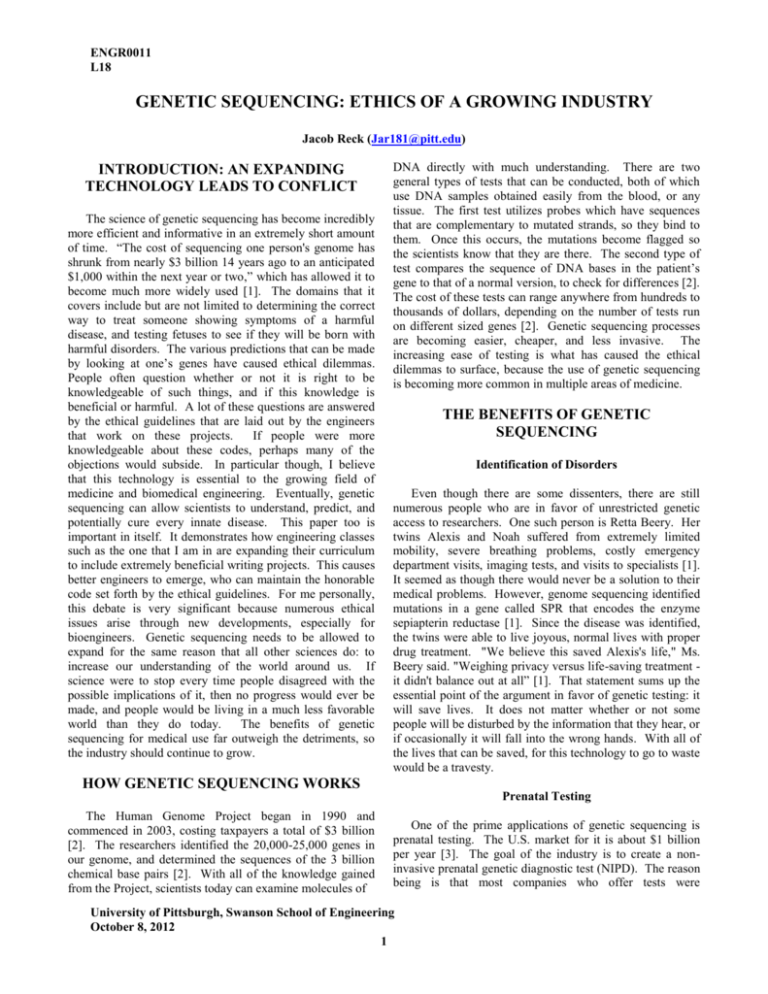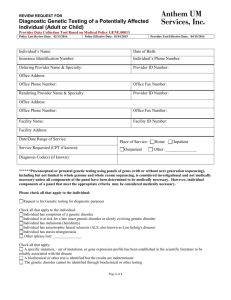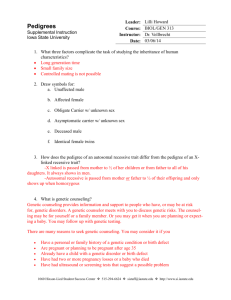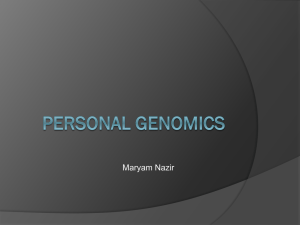Writing Assignment 3 - University of Pittsburgh
advertisement

ENGR0011 L18 GENETIC SEQUENCING: ETHICS OF A GROWING INDUSTRY Jacob Reck (Jar181@pitt.edu) INTRODUCTION: AN EXPANDING TECHNOLOGY LEADS TO CONFLICT The science of genetic sequencing has become incredibly more efficient and informative in an extremely short amount of time. “The cost of sequencing one person's genome has shrunk from nearly $3 billion 14 years ago to an anticipated $1,000 within the next year or two,” which has allowed it to become much more widely used [1]. The domains that it covers include but are not limited to determining the correct way to treat someone showing symptoms of a harmful disease, and testing fetuses to see if they will be born with harmful disorders. The various predictions that can be made by looking at one’s genes have caused ethical dilemmas. People often question whether or not it is right to be knowledgeable of such things, and if this knowledge is beneficial or harmful. A lot of these questions are answered by the ethical guidelines that are laid out by the engineers that work on these projects. If people were more knowledgeable about these codes, perhaps many of the objections would subside. In particular though, I believe that this technology is essential to the growing field of medicine and biomedical engineering. Eventually, genetic sequencing can allow scientists to understand, predict, and potentially cure every innate disease. This paper too is important in itself. It demonstrates how engineering classes such as the one that I am in are expanding their curriculum to include extremely beneficial writing projects. This causes better engineers to emerge, who can maintain the honorable code set forth by the ethical guidelines. For me personally, this debate is very significant because numerous ethical issues arise through new developments, especially for bioengineers. Genetic sequencing needs to be allowed to expand for the same reason that all other sciences do: to increase our understanding of the world around us. If science were to stop every time people disagreed with the possible implications of it, then no progress would ever be made, and people would be living in a much less favorable world than they do today. The benefits of genetic sequencing for medical use far outweigh the detriments, so the industry should continue to grow. DNA directly with much understanding. There are two general types of tests that can be conducted, both of which use DNA samples obtained easily from the blood, or any tissue. The first test utilizes probes which have sequences that are complementary to mutated strands, so they bind to them. Once this occurs, the mutations become flagged so the scientists know that they are there. The second type of test compares the sequence of DNA bases in the patient’s gene to that of a normal version, to check for differences [2]. The cost of these tests can range anywhere from hundreds to thousands of dollars, depending on the number of tests run on different sized genes [2]. Genetic sequencing processes are becoming easier, cheaper, and less invasive. The increasing ease of testing is what has caused the ethical dilemmas to surface, because the use of genetic sequencing is becoming more common in multiple areas of medicine. THE BENEFITS OF GENETIC SEQUENCING Identification of Disorders Even though there are some dissenters, there are still numerous people who are in favor of unrestricted genetic access to researchers. One such person is Retta Beery. Her twins Alexis and Noah suffered from extremely limited mobility, severe breathing problems, costly emergency department visits, imaging tests, and visits to specialists [1]. It seemed as though there would never be a solution to their medical problems. However, genome sequencing identified mutations in a gene called SPR that encodes the enzyme sepiapterin reductase [1]. Since the disease was identified, the twins were able to live joyous, normal lives with proper drug treatment. "We believe this saved Alexis's life," Ms. Beery said. "Weighing privacy versus life-saving treatment it didn't balance out at all” [1]. That statement sums up the essential point of the argument in favor of genetic testing: it will save lives. It does not matter whether or not some people will be disturbed by the information that they hear, or if occasionally it will fall into the wrong hands. With all of the lives that can be saved, for this technology to go to waste would be a travesty. HOW GENETIC SEQUENCING WORKS Prenatal Testing The Human Genome Project began in 1990 and commenced in 2003, costing taxpayers a total of $3 billion [2]. The researchers identified the 20,000-25,000 genes in our genome, and determined the sequences of the 3 billion chemical base pairs [2]. With all of the knowledge gained from the Project, scientists today can examine molecules of One of the prime applications of genetic sequencing is prenatal testing. The U.S. market for it is about $1 billion per year [3]. The goal of the industry is to create a noninvasive prenatal genetic diagnostic test (NIPD). The reason being is that most companies who offer tests were University of Pittsburgh, Swanson School of Engineering October 8, 2012 1 Jacob Reck preforming chorionic villus sampling (CVS), but they are invasive and costly procedures, and carry a small but significant risk of infection, miscarriage or birth defects [3]. NIPD tests were made possible by the 1997 discovery of cell-free fetal DNA in the maternal blood stream. This is easy to isolate, for only 10 milliliters of blood is needed from the mother, and a reliable diagnosis can be given seven weeks after conception [4]. The NIPD test is used to acquire information about the child before it is born. For example, it could examine genes to discover if the child is affected by a trisomy such as Down’s syndrome, or a sex-linked disorder such as Turner syndrome, or if the birth will result in a miscarriage or harm to the mother [5]. These basic, specific benefits are extremely important, because they increase the safety of births. Therefore, it is the future uses of the NIPD tests that frighten people. First of all, informed consent becomes a difficult issue. Doctors and geneticists will need to know what information to reveal, how much information to reveal, how much information to store, and whether or not the patient is capable of making the correct consent decisions [5]. Second, the information obtained could get into the wrong hands. A full scope of the child’s innate health problems could cause the child to be taken advantage of by insurance or health companies. This, however, should not be a worry, because in May 2008, the Genetic Information Nondiscrimination Act was passed, preventing insurance companies from discriminating based upon the results of a genetic test [2]. Perhaps the most heated issue is the increased rate of selective abortion that will happen. “More generalized use of non-invasive testing could facilitate selective terminations of pregnancy in a range of conditions hitherto not diagnosed prenatally and where the arguments for and against termination may not have received sufficient scrutiny” [5]. This means that abortions could occur without the mother having knowledge of the situation, and that the scope of conditions that would lead to an abortion may broaden. For example, a couple may choose an abortion if the child is simply the wrong sex [5]. The vast amount of knowledge that can be gained from these tests will need to be regulated so that it is not abused by businessman, physicians, and patients, but it must be allowed to persist. Eventually, genetic diseases could be eliminated if all of them can be tracked by NIPD tests. However, in the end, the decision still lies with the mother. She will never be forced to terminate her baby, and will not be forced to take this test, so all the NIPD tests are doing is expanding opportunities for those who want them. not reveal facts, data, or information without the prior consent of the client or employer except as authorized or required by law or this Code. [6]” The BMES holds a similar obligation, saying that one must “Regard responsibility toward and rights of patients, including those of confidentiality and privacy, as a primary concern. [7]” These statements relate to one of the core fears that people have about genetic screening, that the information gained will be misused. The public can rest assured though that this will never occur as long as the project is in the hands of a responsible engineer. The NSPE also states that “Engineers shall be objective and truthful in professional reports, statements, or testimony. They shall include all relevant and pertinent information in such reports, statements, or testimony, which should bear the date indicating when it was current.” [6]. This rule of practice means that the genetic engineers must completely inform patients about all of the information that has been obtained, and of all of the applications that arise. Engineers such as I should not see these ethical codes as mere guidelines; they should be viewed as our Hippocratic Oath. It is our duty to the public to be honorable, respectable engineers and to always live up to our prestigious title by being responsible and professional. This is especially made possible by the recent changes in engineering education. EDUCATION: BEYOND THE SCIENCES The way that engineering is taught in schools is changing significantly from the traditional methods. The Journal of Engineering Education states that “Engineering Education must contribute to the development of men who can face new and difficult engineering situations with imagination and competence” [8]. The key term in this sentence is imagination. No longer is the sole focus of engineering education the physical sciences. Institutions have expanded their teaching methods because they have realized the importance of the humanities, and more aesthetic fields. In particular, the Journal emphasizes “an insistence upon the development of a high level of performance in the oral, written, and graphical communication of ideas” [8]. A perfect example of these teachings is a project like this research paper. It not only encourages our imagination by having us look up a research topic that we want to write about, it enhances some of the necessary skills to be an engineer. This research paper causes us to have to think and write professionally. It also makes us start to think like engineers. We have an issue, and now we want to come to a conclusion based upon what we have learned. This is one of the only instances in school when we get to think for ourselves to come up with our own, unique solutions. These essays will help us students to meet engineering qualifications for jobs, and to follow the ethical guidelines required to be a successful engineer. ETHICAL RULES AND IMPLICATIONS Throughout this paper the ethics of genetic screening have been discussed in terms of reactions of the general public. However, specific, official codes of ethics related to this topic exist from the National Society of Professional Engineers (NSPE), and the Biomedical Engineering Society (BMES). For example, the NSPE states that “engineers shall 2 Jacob Reck upon the disorders of the child, but this will only help to eliminate the probability of a genetic disease. Also, that decision lies in the hands of the mother, and will never be forced upon her. This science should be of great concern to all because everyone has genes, so everyone will be affected. The NIPD tests can be available to everyone who is having a child, and anyone could get their own genes screened if they wish. Once some of the better NIPD tests come on the market, everyone who is having a child will have to make the decision whether or not they want one, and how they should interpret the results. Also, there will most likely be great debates between people about how far genetic engineers can go in their testing, interpretations, and documentation. I personally see this science reshaping the way medicine works, especially in regards to childbirth. Genetic sequencing will change the world for the better, into one that is freer of disease, hardship, and a parent’s sorrow over a lost child. SIGNIFICANCE TO ENGINEERS The emerging field of genetic sequencing in medicine is something that I, as a bioengineer, need to be knowledgeable about, because it will revolutionize medicine. An incredible amount of lives could be saved with the diagnoses that can be made. Soon all of medicine will adjust itself to include this science, so engineers must be on board with what is happening. Imagine a society in which there are no negative genetic predispositions. There would be no situations in which someone is cursed from the day they are born to live an incomplete life. Genetic engineering can eventually accomplish this seemingly impossible goal. In addition, the ethical dilemmas which arise from this science are similar to those which I, and other engineers, will face throughout our lives. We engineers need to abide by our written codes if we wish to maintain the integrity of our position. If our own ethical codes are broken, the trust that the general public has for us will be lost. Thankfully though, with the direction education is going, serving these honorable codes will not be a problem. Also, every time there is a new, radical idea which could reshape the world, people will resist it, because they naturally dislike change. This resistance must be overcome for the goal of increasing scientific knowledge in order to improve the lives of everyone in the world. If genetic sequencing can be used to prevent disease, then new doors will be opened for bioengineers to invent new, even more radical methods for solving problems to improve society. REFERENCES [1] S. Boschert. (2012). “Panel to address ethics of genome sequencing.” Internal Medicine News. (Online Article). http://go.galegroup.com/ps/i.do?action=interpret&id=GALE %7CA284961522&v=2.1&u=upitt_main&it=r&p=ITOF&s w=w&authCount=1 p. 14 [2] Human Genome Program. (2010). “Gene Testing.” Human Genome Project Information. (Online Article). http://www.ornl.gov/sci/techresources/Human_Genome/med icine/genetest.shtml CONCLUSION: A TECHNOLOGY THAT AFFECTS EVERYONE [3] BB&T Contributing Editor. (2010). “Interest is growing in prenatal testing for genetic defects” Biomedical Business & Technology. (Online Article). http://go.galegroup.com/ps/i.do?action=interpret&id=GALE %7CA239105764&v=2.1&u=upitt_main&it=r&p=AONE& sw=w&authCount=1 In just a few decades, genetic sequencing has grown from an idea to a science applicable to everyone in the world. Since the Human Genome Project, scientists can examine specific people’s exomes for mutations, or can screen entire sections of their genome. With this technology, genetic screening can be used to identify a genetic disorder by looking at what gene possesses a mutation. This presents an ethical issue: whether or not disclosing information about genetics is a violation of privacy. However, this is a negligible problem to the benefit of saving people’s lives. Also, as long as engineers follow the ethical codes that they have written, the general public has nothing to fear, for they can trust engineers to be transparent and honest. Hopefully, engineers will act in this fashion, especially considering the way that the education systems have changed. With writing skills emphasized further, engineers will know how to better communicate with people. Recently, NIPD tests have been perfected. These can be used to screen fetuses to see whether or not they have genetic diseases, as well as to obtain a multitude of other information. This can cause a huge increase in the number of abortions due to more selective parenting based [4] L. Haymon. (2011). “Non-invasive Prenatal Genetic Diagnosis (NIPD).” Council for Responsible Genetics. (Online Article). http://www.councilforresponsiblegenetics.org/pageDoc uments/E3RTQAOVMU.pdf [5] A. Jong. (2010). “Non-invasive prenatal testing: ethical issues explored.” European Journal of Human Genetics. (Online Article). http://www.nature.com/ejhg/journal/v18/n3/full/ejhg200920 3a.html pp. 272-277 [6] NSPE. (2012). “NSPE Code of Ethics for Engineers.” National Society of Professional Engineers. (Online Article). http://www.nspe.org/Ethics/CodeofEthics/index.html 3 Jacob Reck [7] BMES. (2012). “Biomedical Engineering Society Code of Ethics.” Biomedical Engineering Society. (Online Article). http://www.bmes.org/aws/BMES/pt/sp/ethics [8] L. Grinter. (1994). “Summary of the Report on Evaluation of Engineering Education.” Journal of Engineering Education. (Online Article). https://www.asee.org/papers-andpublications/publications/The-Grinter-Report-PDF.pdf ADDITIONAL SOURCES (2011). “A Next Generation Sequencing Test.” American Journal of Medical Genetics. (Online Article) http://onlinelibrary.wiley.com/doi/10.1002/ajmg.a.341 44/full pp. x-xi (2012). “Incidental Medical Information in Whole-Exome Sequencing.” Official Journal of the American Academy of Pediatrics. (Online Article). http://pediatrics.aappublications.org/content/129/6/e16 05.full pp. 1605-1611 AKNOWLEDGMENTS I would like to thank the writing staff of the engineering analysis classes for their guidance in writing this essay, and my roommate and friends for their understanding and inspiration. 4








